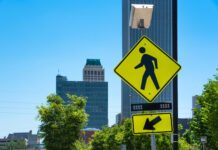A pedestrian bridge was scheduled to be hoisted into place in the early morning hours of Sept. 14, and Shannon Cox was not about to miss it.
Oklahoma City’s always-busy Northwest Expressway was closed from midnight to 5 a.m. between Wilshire and MacArthur boulevards so that the 121-foot-long bridge could be moved into its spot spanning Northwest Expressway, east of Wilshire.
“I wanted to watch that bridge get installed,” says Cox, the city’s public works public information officer, about her decision to burn some midnight oil. “I like to watch things being built.”
The $5.3 million project will link the Lake Overholser and Lake Hefner trails and provide safer passage for walkers, runners and cyclists across Northwest Expressway. Cox expects the bridge to open by the end of the year.
A pedestrian bridge is also part of Tulsa’s West 51st Street Extension Project, a reminder that street departments do much more than fix potholes. In an effort to make transportation safer, more efficient and even more enjoyable, cities spend tax dollars on street widening and resurfacing projects, but also build sidewalks, exercise trails and beautification projects such as median streetscapes.
The 51st Street project will address a quality-of-life issue by reconnecting a street and a neighborhood that was divided when U.S. Highway 75 was built in the 1960s.
“I think that neighborhood is going to be celebrating,” says Paul Zachary, director of engineering for the city of Tulsa. “When U.S. 75 went in between Union and Elwood, it really split the west side of west 51st Street, and stopped communication between Union and Elwood. It just ctreally created a barrier.”
The project will reconstruct about a mile of West 51st Street and will include a sidewalk along the entire length of the street, new bridges and ramps at U.S. 75, and a new connection to the Arkansas River Trail.
The Oklahoma Department of Transportation “is spending hundreds of millions of dollars on the improvement of the Interstate 44 and U.S. 75 interchange,” says Zachary. “So this is a small part of that project.”
RAISE Program
The 51st Street project is a joint effort between ODOT, the city of Tulsa, Tulsa County and other agencies.
Funding comes largely from a $10 million grant awarded under the federal Rebuilding American Infrastructure with Sustainability and Equity (RAISE) program. U.S. Department of Transportation Secretary Pete Buttigieg visited Tulsa in August to champion the bipartisan spending program.
Other Oklahoma projects awarded RAISE grants include $10 million worth of rail crossing improvements in Moore; $16.2 million for a multimodal trail system along the Arkansas River in Tulsa; $1.5 million for a long-range South Western Oklahoma Development Authority regional transportation plant; a $7 million curbing and sidewalk project designed to ease flooding in Wagoner; and $4 million for road and walkway improvement at the Thlopthlocco Tribal Town headquarters.
“Better Streets, Safer City” is the title of an Oklahoma City bond package approved by voters in 2017 to invest more than $1.2 billion in critical infrastructure including police and fire protection, parks, trails, bicycle infrastructure, streets and sidewalks.
“We do about $100 million worth of projects a year,” says Shannon.


























